Soft, pillowy, and wrapped in a beautifully flaky crust, these Sourdough Discard Crescent Rolls are bound to be a hit! Made with commercial yeast, sourdough discard, and a handful of pantry staples, they come together quickly and offer a healthier, more flavorful option than anything from a can.

This recipe is another collaboration with Mimi Council! Each month, we develop creative ways to use sourdough delicious bakes. Check out our recipes for Sourdough Discard Hot Dog Buns, Sourdough Coffee Cake Donuts, Sourdough Discard Whole Wheat Bread and Sourdough Discard Bagels.
Jump to:
- What is a Crescent Roll?
- Making Crescent Rolls at Home
- Why I Love this Recipe
- Ingredients and Substitutions
- Baking with sourdough discard
- Can I make this recipe with active sourdough starter?
- How to Make Sourdough Discard Crescent Rolls
- Baker’s Tips
- Mixer Instructions
- Recipe FAQs
- You may also like
- Sourdough Discard Crescent Rolls
What is a Crescent Roll?
Crescent rolls are crescent-shaped breads with a soft, roll-like crumb and a light, crisp crust. While they may look similar to croissants, they are a bit breadier and less delicate.
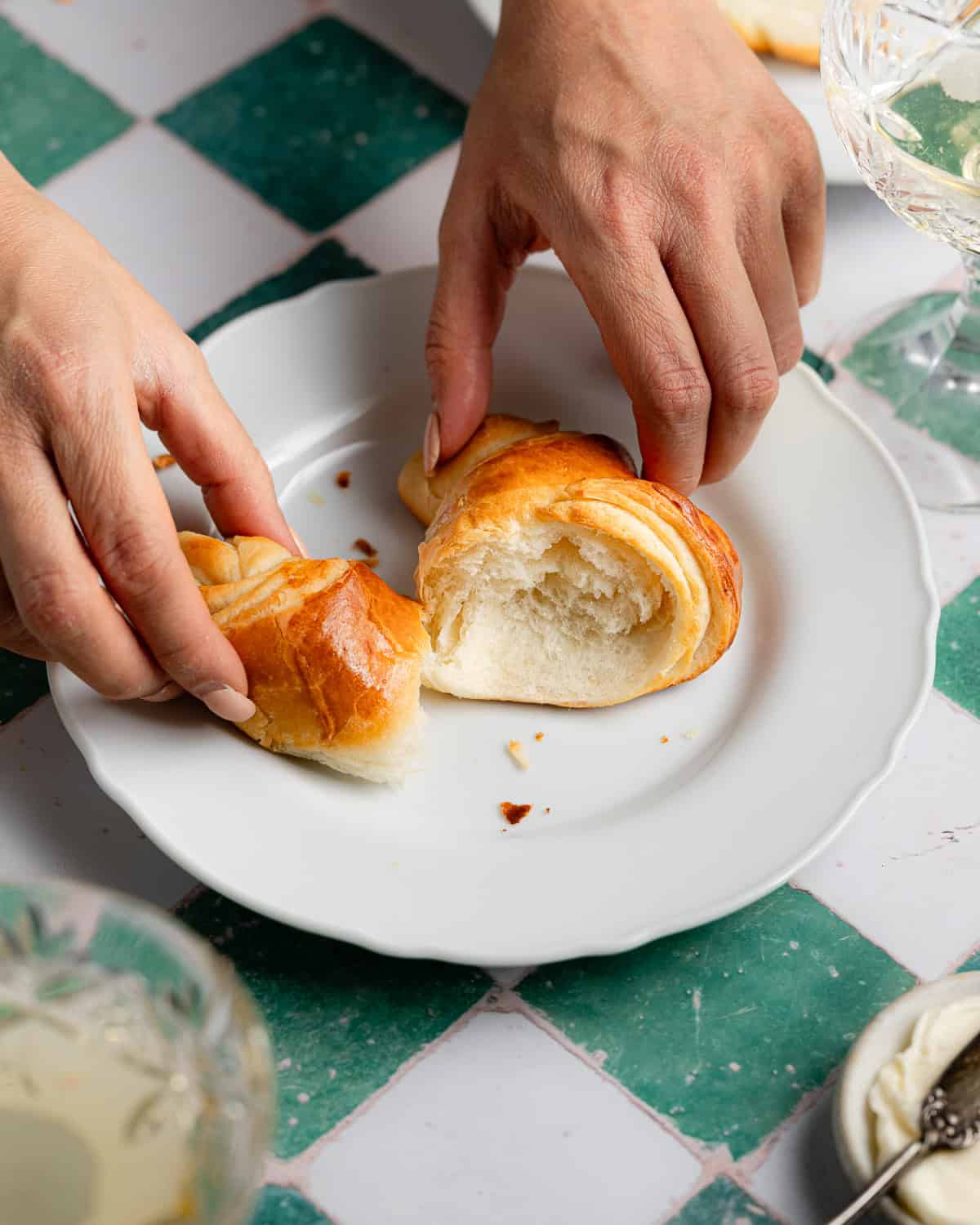
Making Crescent Rolls at Home
Before I started baking sourdough bread at home, I was a huge fan of Pillsbury Crescent Rolls. I loved the quick and uncomplicated process of popping open a can, the satisfying pop as the dough was released, and the intoxicating scent of fresh bread enveloping my kitchen.
While my version takes a bit more time and effort, it captures the same soft and pillowy interior and delicate, flaky crust of an OG crescent roll—but with the added depth of flavor that only sourdough discard can bring. Plus, there’s something rewarding about making these rolls from scratch, with high-quality ingredients.

Although store-bought crescent rolls rely solely on baking powder as a leavener, I developed this recipe with yeast, as it produced the fluffiest bread during testing. While I aimed to stay true to the original, I prioritized enhancing both taste and texture.
Why I Love this Recipe
- Mixed by hand, no stand mixer required.
- Great way to use up a lot of sourdough discard!
- Delicious sourdough flavor, fluffy texture with a flaky crust.
- Made with simple ingredients.
Ingredients and Substitutions

All-purpose flour: The low protein content of all-purpose flour imparts a plush texture to these crescent rolls. You can substitute bread flour in a pinch, but do not use whole wheat flour. Need help figuring out which flour to use in your recipes? Check out my post on The Best Flour for Sourdough.
Active-dry yeast: You can also use instant yeast for this recipe, feel free to skip the blooming step if you choose you do so.
Sourdough discard: Both active starter and sourdough discard work for this recipe. If you don’t have a sourdough starter, add 56 grams flour and 56 grams water to your dough.
See recipe card for detailed ingredient information.
Baking with sourdough discard
Sourdough discard is any portion of your sourdough starter not used to make bread. Instead of throwing it away, you can use it to make other baked goods and even Sourdough Pasta!
The addition of sourdough discard contributes a rich and nuanced flavor to these crescent rolls. Since the sourdough starter is used solely for flavor enhancement, there's no need to activate or feed it and you can use it directly from the refrigerator.
Can I make this recipe with active sourdough starter?
Absolutely! However, you'll need to adjust the fermentation time for the dough. Instead of a quick rise, allow it to rest for about 4 to 6 hours, or until it has doubled in size.
If you’re omitting the yeast, simply replace the sourdough discard in the recipe with an equal amount of active sourdough starter.
How to Make Sourdough Discard Crescent Rolls
STEP 1: Make the dough
Bloom the yeast. Rub butter into the flour. Mix the flour and sourdough discard into the yeast mixture. Knead the dough until smooth and elastic.

Tip
Rubbing the butter into flour helps create a delicate flaky crust and a fluffy crumb.
STEP 2: Bulk fermentation
Bloom the yeast. Rub butter into the flour. Mix the flour and sourdough discard into the yeast mixture. Knead the dough until smooth and elastic.

STEP 3: Laminate the dough
Divide the dough into 5 balls. Flatten each portion of dough into an 8-inch circle and spread an even layer of butter on top. Flatten each portion of dough into an 8-inch circle and spread an even layer of butter on top. Repeat with the remaining portions of dough. Stack the dough, making sure the edges line up neatly. (Note: Do not spread butter on the portion of dough that goes on the very top.)

I discovered this ingenious method of laminating dough from Betul Tunc from Turkuaz Kitchen.
STEP 4: Divide the dough
Pinch to seal the edge of the dough. Roll the dough out into a 15-inch circle, about ⅛-inch thick. Spread the remaining butter on top of the dough. Cut the dough into 12 triangles.

STEP 5: Shape the crescent rolls
Take 1 portion and make a small slit in the middle of the base of the triangle. Pull the two bottom corners outward, and roll the dough towards the tip. Place the shaped dough on a large parchment-lined baking sheet and curve the ends so that the dough resembles a crescent shape (give the dough room to rise and spread).

STEP 6: Bake
Let the dough rise in a warm spot until puffy and doubled in volume, about 3 to 45 minutes. Bake at 350 F for 25 to 30 minutes.

Baker’s Tips
- Weigh your ingredients. Measuring by weight is much more accurate than by volume (with tablespoons and cups).
- Commercial yeast has a shelf life. Make sure yours yeast is not expired before attempting this recipe.
- Both sourdough discard and active sourdough starter will work for this recipe.
- Knead the dough until smooth. Gluten development is essential for these rolls. A strong gluten network will allow the dough to capture and retain carbon dioxide during the fermentation process. This results in tender, pillowy rolls.
- Roll the dough out until it’s very thin; this helps create the signature flaky layers of a crescent roll.
Mixer Instructions
- Combine the ingredients in the bowl of a stand mixer, use a paddle attachment to stir the ingredients together.
- Once the dough appears cohesive, switch to a dough hook and mix until the dough clings to the hook and away from pulls away from the sides of the bowl.
- Turn the dough out on a clean surface. Knead the dough for 1 to 2 minutes until smooth and pliable.
- Round the dough into a ball and place into a clean bowl.
- Then proceed with the recipe as instructed.

Recipe FAQs
Sourdough discard is any portion of your starter removed during the feeding process or any part not used to leaven sourdough bread. You can use it in other bakes and dishes or store it in the refrigerator.
Your yeast may have been expired, or your kitchen may have been too cold. Try proofing your dough in a warmer spot, such as your oven with the light on but turned off.
Crescent rolls have a soft, bready texture with a slightly flaky crust and a mild, buttery taste. In contrast, croissants are light and airy with a crisp, flaky texture and a rich, buttery flavor from the laminated dough layers.
You may also like
Did this recipe rise to the occasion?
★★★★★
Please leave a star rating and a comment. Your feedback helps me create more delicious sourdough recipes. I read and truly appreciate every message.
Don't forget to PIN this recipe on Pinterest to save it for later!
Thank you for your support!

Sourdough Discard Crescent Rolls
Equipment
- palette knife
This section may contain affiliate links
Ingredients
Dough
- 28 grams sugar
- 7 grams active-dry yeast
- 170 grams milk
- 113 grams sourdough discard
- 42 grams unsalted butter softened
- 300 grams all-purpose flour
- 8 grams salt
Filling
- 70 grams salted butter softened
Topping
- 1 egg
Click US Customary to view volume measurements
Instructions
- Activate the yeast: Whisk the sugar, milk, and yeast in a large bowl. Cover and let the yeast bloom until foamy, at least 15 minutes.
- Make the dough: Stir the sourdough discard into the yeast mixture until fully incorporated.
- Whisk the salt and all-purpose flour together. Rub the unsalted butter into the flour until coarse crumbs form.
- Create a well in the center and pour the yeast mixture in. Stir until no traces of dry flour remain.
- Working inside the mixing bowl, knead the dough until it looks cohesive. If your dough is too sticky, cover the bowl with plastic wrap and let it rest for 15 minutes.
- Knead the dough: Turn the dough out on a clean work surface. Knead the dough until smooth, about 5 to 10 minutes. Round the dough into a tight ball and transfer it to a lightly greased bowl.
- Bulk ferment: Cover the bowl with plastic wrap and let the dough rise until doubled in volume, about 45 minutes to 1 hour (depending on the temperature of your kitchen).
- Laminate the dough: Divide the dough into 5 even portions. Roll each portion of dough into a ball. Cover the dough with plastic wrap and let it rest for 10 minutes, this will make it easier to roll out.
- Working with 1 portion of dough at a time, roll the dough into a 8-inch circle using a rolling pin.
- Spread a tablespoon of butter on top of the disc, cover with plastic wrap.
- Repeat with the remaining portions of dough, stacking each circle of dough on top of the previous one and spreading 1 tablespoon of butter on top, but do not spread butter on the top layer! (This will make rolling out the dough when shaping much easier.)
- Pinch the edges of the dough together so the layers do not separate.
- Transfer the layered dough to a plate and chill the dough for 1 hour.
- Prep: Preheat the oven to 350 F and line a large baking sheet with parchment paper.
- Shape the dough: Place the dough on a clean work surface. Use a rolling pin to roll it out into a large circle, about 15 to 18 inches, it should be quite thin (⅛-inch thick).
- Using a pizza cutter or chef’s knife, divide the dough into 12 even segments (like a pizza).
- Working with 1 triangle at a time, make a small slit in the middle of the base of the triangle. This will allow the dough to be curved into its iconic shape, so it’s important to make this cut.
- Pull the two bottom corners outward, and roll the dough towards the tip.
- Place the shaped dough on a large parchment-lined baking sheet and curve the ends so that the dough resembles a crescent shape (give the dough room to rise and spread). Repeat with the remaining portions of dough.
- Final proof: Cover the baking sheet with plastic wrap and let the dough rise until puffy and has noticeably increased in volume, about 30 to 45 minutes.
- Bake: Whisk the egg. Brush the tops of the dough with egg wash. Bake for 20 to 30 minutes or until the crescent rolls are golden brown.
- Enjoy: These rolls are best served fresh out of the oven.
- Store: Store any leftovers in an airtight container at room temperature for up to 3 days. Refresh the rolls in an oven toaster for 5 minutes.
Tips
These recipes were developed and tested using grams for precise measurements. To increase your chances of success, I recommend investing in a kitchen scale. I've included rough volume estimates (in tablespoons and cups), but they might not be totally accurate.
Remember all ovens are unique, these recipes were tested in my oven which runs cooler than others. You might need to lower the temperature if your bake appears to be browning too quickly. Monitor your bake closely and make adjustments if needed.
Notes
- Make sure your yeast is not expired before baking these rolls or your dough may not rise.
- Give your dough enough time to rise, waiting until it has doubled in volume before shaping or baking. Otherwise, your bread may be dense and gummy.
- Feel free to use active sourdough starter or sourdough discard to make this recipe.
- Both instant yeast and active dry yeast will work to make this recipe.
Nutrition
I am not a nutritionist or dietitian, any nutrition information provided is an estimate.


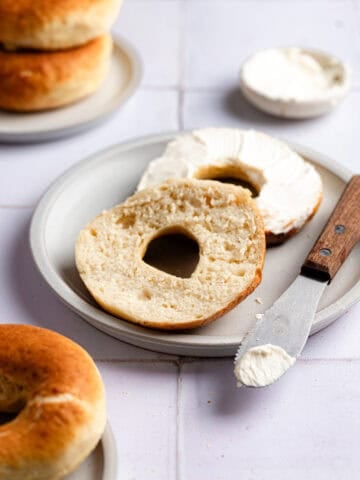
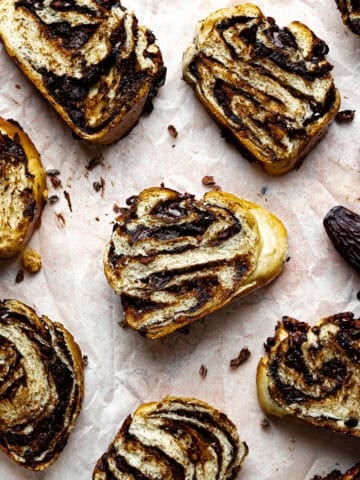

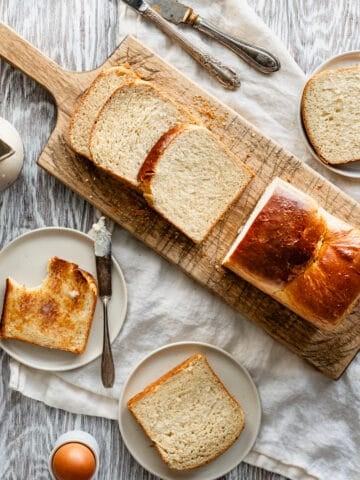

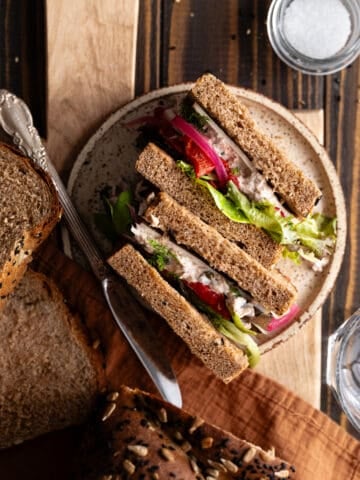
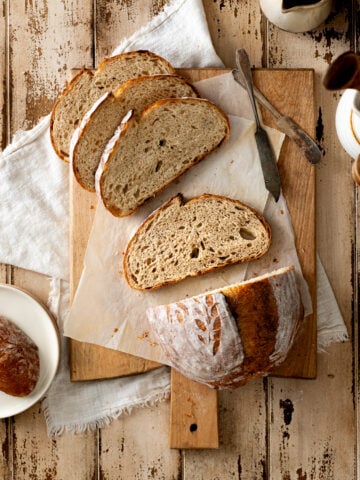
Did you make this recipe? Do you have questions? Let me know below!